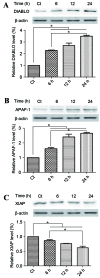Phloretin induces apoptosis of human esophageal cancer via a mitochondria-dependent pathway
- PMID: 29151915
- PMCID: PMC5680639
- DOI: 10.3892/ol.2017.7037
Phloretin induces apoptosis of human esophageal cancer via a mitochondria-dependent pathway
Abstract
2,4,6-trihydroxy-3-(4-hydroxyphenyl)-propiophenone (phloretin) is found in apple tree leaves and the Manchurian apricot, and is a potent compound that exhibits anti-inflammatory, antioxidant and antitumor activities. However, the effect of phloretin on esophageal cancer cells is not well-defined. The present study aimed to examine whether and how phloretin induced apoptosis in human esophageal cancer cells. EC-109 cells were cultured in Dulbecco's modified Eagle's medium and incubated with 60, 70, 80, 90 and 100 µg/ml phloretin for 6, 12, 24 and 48 h. Cell proliferation was measured by an MTT assay. Cell apoptosis rate was measured using flow cytometric analysis subsequent to propidium iodide (PI) staining. The protein expression levels were determined by western blot analysis. It was found that phloretin significantly decreased viable cell numbers in a dose- and time-dependent manner and induced apoptosis in EC-109 cells. Additionally, phloretin exhibited potent anticancer activity in vitro, as evidenced by the downregulation of the anti-apoptosis-associated molecule B-cell lymphoma 2 (bcl-2) and an increase in the levels of the apoptosis-associated molecules bcl-2-like protein 4 and tumor protein p53. Phloretin treatment also affected the expression of apoptotic protease activating factor-1, the protein product of the direct binding of the inhibitor of apoptosis protein with low PI to the X-linked inhibitor of apoptosis protein. The present results indicated that phloretin may inhibit EC-109 cell growth by inducing apoptosis, which may be mediated through a mitochondria-dependent pathway.
Keywords: apoptosis; mitochondria-dependent pathway; phloretin.
Figures





References
-
- Raymond DP, Seder CW, Wright CD, Magee MJ, Kosinski AS, Cassivi SD, Grogan EL, Blackmon SH, Allen MS, Park BJ, et al. Predictors of major morbidity or mortality after resection for esophageal cancer: A society of thoracic surgeons general thoracic surgery database risk adjustment model. Ann Thorac Surg. 2016;102:207–214. doi: 10.1016/j.athoracsur.2016.04.055. - DOI - PMC - PubMed
-
- Wu XD, Qin HY, Zhang JE, Zheng MC, Xin MZ, Liu L, Wu XJ, Jiang CN, Zhang MF. The prevalence and correlates of symptom distress and quality of life in Chinese oesophageal cancer patients undergoing chemotherapy after radical oesophagectomy. Eur J Oncol Nurs. 2015;19:502–508. doi: 10.1016/j.ejon.2015.02.010. - DOI - PubMed
LinkOut - more resources
Full Text Sources
Other Literature Sources
Research Materials
Miscellaneous
